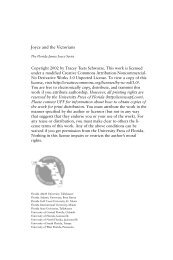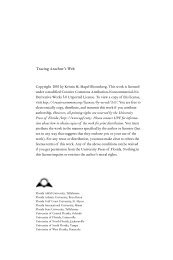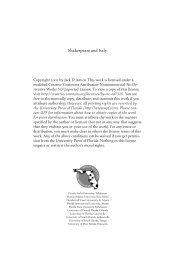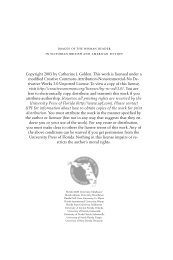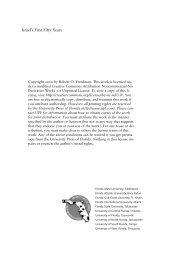Bernard Shaw's Remarkable Religion: A Faith That Fits the Facts
Bernard Shaw's Remarkable Religion: A Faith That Fits the Facts
Bernard Shaw's Remarkable Religion: A Faith That Fits the Facts
Create successful ePaper yourself
Turn your PDF publications into a flip-book with our unique Google optimized e-Paper software.
Ethics, Economics, and Government 151<br />
able to only one. Of course, she might also, if her ire was roused by <strong>the</strong><br />
idealist’s tone of moral superiority, borrow a line from Andrew Undershaft<br />
and accuse him of “lusting after personal righteousness.” She might even<br />
declare that to demand <strong>the</strong> lives of 100 o<strong>the</strong>r men in satisfaction of that<br />
lust is an act of extreme egoism and selfishness. Or she might be reminded<br />
of <strong>the</strong> lesson of The Doctor’s Dilemma and realize that she cannot be sure<br />
of her own motives: <strong>the</strong>re is no such thing as a completely objective decision.<br />
I stress again that <strong>the</strong>re is no rational way to arbitrate between <strong>the</strong><br />
choice of <strong>the</strong> idealist and that of <strong>the</strong> realist, but in this instance <strong>the</strong> quest<br />
for personal righteousness would certainly exact a high price.<br />
Moral Development: Male and Female<br />
There is a reason for <strong>the</strong> identification of <strong>the</strong> idealist as male and <strong>the</strong> realist<br />
as female, beyond an acknowledgment that both men and women make<br />
moral decisions. Modern thinking about moral development has caught up<br />
with Shaw in interesting ways. Until recently, ideas about <strong>the</strong> moral development<br />
of children were dominated by <strong>the</strong> <strong>the</strong>ories of Lawrence Kohlberg,<br />
who developed a hierarchy of moral development in children that placed<br />
abstract principles as <strong>the</strong> last and presumably highest stage. Boys did better<br />
than girls on this scale. One of his students, Carol Gilligan, has made<br />
her reputation revising <strong>the</strong>se <strong>the</strong>ories. She did not reject Kohlberg’s empirical<br />
findings, she merely looked at <strong>the</strong>m through different eyes—a<br />
woman’s eyes—and showed that <strong>the</strong>re was no reason why <strong>the</strong> moral development<br />
of boys should be regarded as normative or superior to that of<br />
girls. The moral criteria that girls used were different, but no less sophisticated<br />
and thoughtful, from those generally employed by boys. Whereas<br />
<strong>the</strong> boys applied abstract rules, <strong>the</strong> girls asked how much suffering would<br />
result from a given action. Then <strong>the</strong>y would choose <strong>the</strong> action that produced<br />
<strong>the</strong> least harm. Gilligan does not go as far as Shaw; she merely says<br />
that <strong>the</strong> criteria of <strong>the</strong> girls is as valid as that of <strong>the</strong> boys, whereas Shaw<br />
would have declared it superior.<br />
The simplest form of moral relativism can spark conflict between idealists<br />
and realists, but a particularly sensitive area is cultural relativism,<br />
which sees moral values as dependent on <strong>the</strong> culture in which <strong>the</strong>y exist.<br />
Like moral subjectivism, cultural relativism seems to question <strong>the</strong> very<br />
validity of moral standards by suggesting that <strong>the</strong>y are entirely arbitrary<br />
and conventional. This objection is more serious than relativists and subjectivists<br />
generally acknowledge. Cultural relativism suggests that good<br />
and ill are whatever <strong>the</strong> society says <strong>the</strong>y are; moral subjectivism suggests



